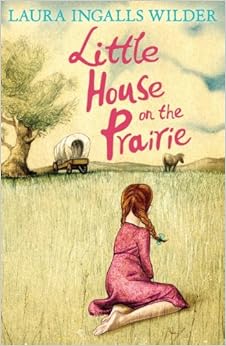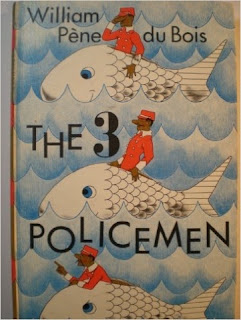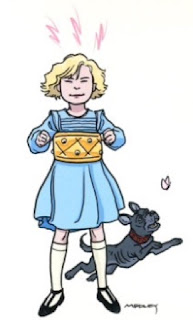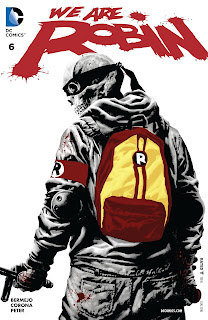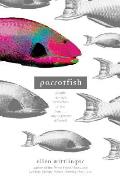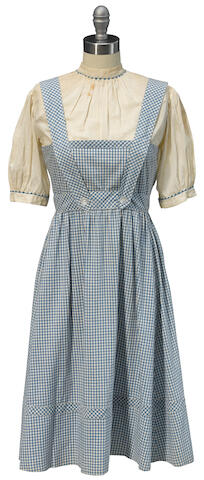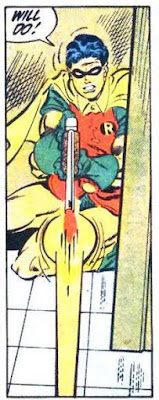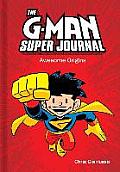new posts in all blogs
Viewing Blog: Oz and Ends, Most Recent at Top
Results 1 - 25 of 2,196
Musings about some favorite fantasy literature for young readers from a writer with over ten years of experience as a book editor.
Statistics for Oz and Ends
Number of Readers that added this blog to their MyJacketFlap: 1
At the Hungry Tiger Talk blog,
David Maxine has written about the one-of-a-kind Oz-related item that was part of our first meeting, when we were teenagers. This is my side of the story.
Back in 1979, at the age of thirteen, I attended my first International Wizard of Oz Club convention. This was the Munchkin Convention, meaning it drew Oz fans from the eastern part of the United States. In the books, you see, the Munchkins live in the eastern part of Oz. (In
most of the books. It’s a long story, which David summarized
here.)
That year the Munchkin Convention was in Cherry Hill, New Jersey, a reasonably short car ride from my grandparents’ home in suburban Philadelphia. I’d already done some air travel by myself, so I felt confident flying down to visit Grandpa and Grandma.
I wasn’t so confident about meeting the Munchkin conventioneers. I was a shy kid, and I’d never been at that sort of gathering before, much less on my own. It turned out to be a milestone event because it was the first time adult strangers treated me as a peer. For that, I’ll always be grateful to the Oz Club.
There were other teenagers there as well, or at least one: Judy Bieber. But she intimidated me. I was thirteen, and she was (and remains) a couple of years older, which felt like an incredibly significant gap. She was also smart, pretty, and seemingly very much at home in Munchkinland. She created the quiz about the Oz books for that year. She and her father Herm were selling older Oz editions. She appeared to have everything.
To the surprise of the room, and the astonishment of myself, I won Judy’s quiz. The Oz books were the first field of knowledge I really tried to master, and my brain is good at retaining trivial information. And, though I didn’t know it at the time, previous winners were probably sitting out that event. The prize that Judy supplied was an abridged “Junior” edition of
Rinkitink in Oz with some John R. Neill color plates. I’m sure that was the first time I’d ever seen one of those abridgments. It may have been the first time I ever knew about them.
By the end of that day, while I was waiting for my grandmother to pick me up, I was already worrying about my responsibilities for the following year. The winner of each year’s quiz had to write the next year’s quiz and supply the prize. I remember another attendee congratulating me on winning and asking if I was already thinking about new questions, and me replying that I was already thinking about the
prize.
Making the quiz was fun. I decided to base it on Neill’s pictures and books, and I had fun laying it out. But for a prize? I didn’t have much money to spend, I didn’t know the range of possibilities, and I wasn’t linked into collectors’ networks. I also wasn’t good at asking for help (I’m still not). I wanted to solve this problem on my own—since I was acting as an adult, and all that.
So I decided to use my time in woodworking class to make a prize. A pair of O and Z bookends didn’t work out, but I grabbed a piece of mahogany and figured out a design for a cheese board that incorporated Neill’s OZ symbol in its handle. I didn’t do a great job with the carving, but it was a one-of-a-kind Oz-related trophy. And its real value was symbolic, right?
As David guessed, during the 1980 Munchkin Convention I decided to augment that cheese board with an edition of
The Wizard of Oz autographed by Margaret Hamilton, who was there. So now I can also say that I had a brief conversation with her. Very brief.
The person who won my quiz was David Maxine, who had come from out west all the way to Cherry Hill. He was also a teenager. But, like Judy, he was (and is) a couple of years older than me. The difference is minuscule now—we’re all part of what I called the “white cover generation” of Oz fans. [Well, the difference will be significant for one more week while I’m still in my forties and Judy and David are over fifty.] But back then David was also daunting.
Looking back, I realize that my thinking at thirteen was skewed by the universal adolescent assumption that every other teen is having more fun than you. To me David seemed like an old hand at Oz conventions and collecting and life. I should have perceived that this was his first time at the Munchkins, and he had no idea I was at just my second gathering. We had more in common than I realized.
If I’d known the winner of my quiz was going to be another teen, I probably wouldn’t have made a kitchen implement. If I’d had the boldness to befriend Judy the year before, I could probably have asked her and Herm to snatch up one of those abridged editions for the 1980 prize. But I couldn’t see any of those possibilities at the time.
I also couldn’t see that David and I would reconnect in something called “online” almost twenty years later. During some Ozzy conversation he mentioned that he still had the cheese board, which was both astonishing and gratifying. (As he’s pointed out, it’s compact and almost impossible to break.) And now that we’re both adults and have had online exchanges about such things as Swiss chard, a kitchen implement turns out to have been more appropriate than we knew. It’s come to symbolize a real-world friendship rooted in Oz.
Matt Santori-Griffith’s interview with
Grayson artist Mikel Janin at Comicosity in January was mostly the upbeat puffery we should expect from comics creators while they’re still marketing their current magazines. Nevertheless, it contains some
Janin was expecting to take over
Nightwing, costume and all, before plans and editors changed:
Former editor Mike Marts asked me to join Nightwing and, after more than two years in Justice League Dark, I was thrilled to be part of such an important and loved character.
But when things started to roll, I realized this was a totally new direction for Dick Grayson. There were a lot of changes, with editor Mark Doyle taking the project, and everything went full speed very quickly!
I sense the plan to launch
Grayson came from the top of DC, so the change in editors was probably coincidental rather than causal.
Another sign of the writers’ fondness for the long history of the Dick Grayson character shows up in the fight scenes:
Tim Seeley gave me some references of actual Robin fight scenes in the Golden Age, and I tried to bring the energy and the happiness of this young boy we all know and love to Dick’s moves, less elaborated than Nightwing’s graceful moves, just direct action to the face. It was really fun to do!
And the different strengths of the two
Grayson writers, Tim Seeley and Tom King:
Tim brings some crazy ideas and sense of wonder, going to places you only can go in comic-books. He has an incredible ability to bring rhythm and fun to the book. Tom digs deep to character’s heart, and has a sense of pace that makes you feel like you’re into a movie.
The
New York Times article on the arrest of pharmaceutical investor Martin Shkreli begins:
It has been a busy week for Martin Shkreli, the flamboyant businessman at the center of the drug industry’s price-gouging scandals.
He said he would sharply increase the cost of a drug used to treat a potentially deadly parasitic infection. He called himself “the world’s most eligible bachelor” on Twitter and railed against critics in a live-streaming YouTube video. After reportedly paying $2 million for a rare Wu-Tang Clan album, he goaded a member of the hip-hop group to “show me some respect.”
All in one week? That makes me wonder if something biochemical is going on, and Shkreli’s famous obnoxiousness is fueled by mania. Like his alleged decision to do fraudulent things with people’s money.
Back in 1981, the Children’s Theatre Company and School of Minneapolis staged a production of L. Frank Baum’s
The Marvelous Land of Oz. On its blog the company has posted
some photographs and videos of the show, along with these production notes:
Originally, the production was to be mounted by a guest writer/director but, ultimately, his concepts were felt not to be a good aesthetic match with the Company and so, fairly last-minute, the production team changed. Artistic Director John Clark Donahue assumed the role of stage director and Thomas W. Olson, resident playwright who previously that season had created the scripts for "The Story of Babar, the Little Elephant" and "The Clown of God," quickly began working on a new adaptation, while Gary Briggle was engaged to write lyrics with Richard A. Dworsky's music. . . .
At the time, ticket prices were $6.95 for adults and $4.95 for children, general seating. . . .
With "The Marvelous Land of OZ," the Company embarked on a three-year relationship with professional video producers The Television Theatre Company, shutting down the theatre for two weeks at the end of the season and transforming the auditorium into a video soundstage. The following winter, "The Marvelous Land of OZ" was distributed by MCA/Universal for cablecast on Showtime/HBO (winning a cable ACE award for outstanding family entertainment) and was also made available for home purchase on videocassette.
I saw the show when it was on cable TV and was impressed by how closely it followed the book. It was obviously a filmed stage production, not a movie, but it was a good one.
At the bottom of
this posting about the CTC’s 1980-81 season are more photos from
The Marvelous Land of Oz, what looks like a complete scan of the program, and the
Minneapolis Tribune review. Plus some shots of Edward Albee looking grumpy and (connected to a previous show) Tomie De Paola looking svelte.
Travis Rozier and
Bob Hodges have put out a call for papers on “The Weird & the Southern Imaginary,” with a deadline of January 18, 2016.
They state:
The Weird & the Southern Imaginary will introduce the aesthetics and generic conventions of the Weird to cultural studies of the U.S. South and the region’s local, hemispheric, and (inter)national connections. Contributions from literary critics, film and popular culture scholars, philosophers, and critical theorists will consider forms of the Weird in a range of texts (literature, art, film & television, comics, music) from, about, or resonant with conceptions of different South(s).
And in more detail:
S. T. Joshi periodizes Haute Weird Fiction from 1880 to 1940, and China Miéville describes how the paradigm of Haute Weird Fiction, especially in its foremost practitioner H. P. Lovecraft, invokes horror, alterity, and/or awe on a cosmic scale, which seeps into the mundane experiences of cognitively ill-equipped scientific or academic protagonists. The Weird aesthetic, especially pre-World War II, is often inextricable from revanchist horrors of democracy, political revolution, miscegenation, and female or other non-normative sexualities, although Ann and Jeff VanderMeer’s recent Weird compendium stresses the “darkly democratic” aspect of a C20 and C21 Weird tradition that spans nations, genders, genres, and levels of literary status.
Representations of the U.S. South as an irrational or reactionary space draw on what Deborah Barker and Kathryn McKee describe as the southern imaginary, a fluid reservoir of topoi referencing an enduring material history of land appropriation, coercive labor practices, carceral landscapes, racial and commercial mixing, extralegal violence, and insular patriarchies. The Weird & the Southern Imaginary will explore Weird South(s) of national aberrance and cosmic otherness. For example, the first television season of True Detective melds the conservative politics and religious fervor often equated with the South to vaster hints of conspiratorial and cosmic horror in a postindustrial Louisiana swampscape.
The dark fantasy of the Weird diverges sharply from the usual monstrosities of horror and speculative fictions as well as many modes of southern representation: the gothic, the grotesque, the uncanny, the ghostly or hauntological, or the folkloric, modes with longstanding southern associations and almost as longstanding critical fatigue for Southernisits. The Weird can also bridge Southern Studies and its old associations with recent work in object-oriented ontology, ecotheory, other new materialisms, and nihilist philosophy as well as apocalyptic popular cultural fixations.
Possible topics include:
- Weird South(s) in U.S. literature
- International Weird Fiction & southern imaginary, subtly connected or not
- Race & the southern imaginary in Weird Fiction
- Political or cultural reaction & Weird South(s)
- Weird carceral practices & the southern imaginary (Franz Kafka “In the Penal Colony”)
- Environmental transformation or degradation & Weird South(s)
- The nonhuman or posthuman in southern literature (Matthew Taylor)
- Dark ecology (Timothy Morton) & southern landscapes, swampscapes, etc.
- Nihilism, extinction, or the recalcitrance of the world (Eugene Thacker) & the South(s)
- C19 South & proto-Weird Fiction (Ambrose Bierce, Charles Chesnutt, Edgar Allan Poe)
- The Weird associations of the South & the Antarctic (Poe, Herman Melville, Lovecraft)
- R. H. Barlow in Florida, his Weird Fiction, or his correspondence with Lovecraft
- Robert E. Howard in Texas, his Weird Fiction, or his correspondence with Lovecraft
- Weird Appalachia (Lovecraft, Manly Wade Hopkins’s Silver John stories, Fred Chappell)
- Henry S. Whitehead’s Weird West Indian tales
- Eudora Welty & Weird Fiction (Mitch Frye)
- Weird Fiction, modernist literary strategies, & the South (William Faulkner, Zora Neale Hurston “Uncle Monday”, Flannery O’Connor)
- The Weird in Latin American Boom fiction (Julio Cortázar, Carlos Fuentes, Gabriel García Márquez, Augusto Monterroso), its forbearers (Jorge Luis Borges), or its successors (Junot Díaz, Jamaica Kincaid)
- Contemporary or New (South) Weird (Poppy Z. Brite, Moira Crone, Stephen Graham Jones, Caitlín Kiernan, Joe Lansdale, Joyce Carol Oates, Jeff VanderMeer)
- Weird southern comics (Alan Moore et al. Saga of the Swamp Thing, Garth Ennis et al. Preacher)
The editors want essays in English, 5,000-8,000 words long. But the first step is to send them a 300-500 word abstract at the emails linked to their names above.
Earlier this week I attended an unusual book event at the Public Library of Brookline.
Author M. T. Anderson read the introduction of his new nonfiction book,
Symphony for the City of the Dead: Dmitri Shostakovich and the Siege of Leningrad. He spoke about Shostakovich’s String Quartet No. 8, composed well after the war but perhaps looking back on it. Then the
Arneis Quartet performed that work. nd finally Anderson took questions.
The audience was big enough that the librarians had to bring in more chairs, which is always gratifying for event organizers. Always better to underestimate turnout by a little than to overestimate. As at most cultural offerings, the audience leaned toward the senior side rather than Anderson’s usual readership of teens and middle-graders.
There were some kids there with their parents. I assumed they were fans of Anderson’s
Pals in Peril! series. I wondered what they were thinking about this much more serious presentation, with historical/musical analysis of a composition that even some classical music fans find puzzling.
During the question session, one of those kids eagerly raised his hand. He was sitting with a friend the same age and one of their fathers. He had a bowl haircut and a big hole in one of the knees of his trousers. I wondered, how far off the topic of this event was his question going to be?
“I read your book,” he told Anderson. “How long did it take to you find out all this stuff?”
Five years of research, Anderson explained. And we all learned something.
Recently a reporter from the
Washington Post sat in on a focus group organized by Frank Luntz, the GOP pollster and message-shaper. Luntz was trying to find out, on behalf of the Republican Party establishment, what could shake Donald Trump’s followers.
It turned out the big problem is OIP Derangement Syndrome, spread by the American right over the past seven years. For example, here’s a man who pictures burning the President alive:
Frank Lanzillo, a 59-year-old retired marine, took that as a cue to explain just how anti-American the president really was.
“When you bend down to the Saudis, take your shoes off, put your hand on a Koran and then the Bible when you’re sworn in?” Lanzillo said. “He took his flag pin off. I’m a Marine and former deputy sheriff. He took that off, he was in the toilet to me. I would not only not piss on him if he was on fire — I’d throw gas on him.”
(The president briefly chose not to wear a flag pin during the 2008 campaign; he was not sworn in on a Koran.)
Asked if the president was a Christian, only three of the 29 participants raised their hands. Asked if he was born in the United States, eight said no. When Luntz returned to policy, mistrust of the president informed the exclamations of trust in Trump.
As a result of OIP Derangement Syndrome, these voters were unable to process factual information from Luntz. No evidence of Trump’s policy extremes, boorish manners, or distance from reality could shake their loyalties. They’re sticking with Trump, and the GOP is stuck with them.
Last week as
The Wiz was about to air on television,
Mark Evanier unspooled his story about being hired to script an adaptation of the 1978 movie version for DC Comics.
It’s most interesting, like a lot of the stories on Evanier’s website, for the backstage look at how comics companies work. (Which is to say, barely.) There are also some nicely crafted lines:
- “Not far enough before the film's scheduled premiere, someone at or around DC Comics got the idea to publish a slick magazine which would be part comic book, part souvenir book for lovers of the movie. This was some time before anyone knew there wouldn't be a lot of lovers of that movie.”
- “I had to sign all sorts of non-disclosure agreements that I would not divulge what I saw to anyone and as I recall, they didn't specify any time limit. I mean, I was supposed to write all these authorized articles about what was in the movie and here I was signing vows that I would never in a million years divulge to anyone what was in the movie. So I may be violating those agreements right now.”
- “I forget what they were going to charge for it but it struck me as a bit too pricey. It also struck me as not my problem.”
- “By far, most of my time went into going up to Universal to see a more-complete version of the movie and then to see an even-more-complete version. I saw it three times but I never saw the final release cut. I felt that the film got better as the holes were filled in…which is not to say I thought it ever got to be really good. The merits it did have were (a) a few of the actors’ performances and (b) some truly dazzling dance numbers. And of course, it did dawn on me that our adaptation would contain neither.”
For the stories of which artist should work on this project, how the 1976 Copyright Act affected things, why no one has ever heard of this comic, and how its obscurity might have helped Evanier and artist Dan Spiegle’s careers, check out
Evanier’s recollection.
Of all the famous dramatic adaptations of L. Frank Baum’s
The Wonderful Wizard of Oz,
The Wiz in its original form is the most faithful. But of course the 1939 MGM movie is now more famous than either version.
As I observed yesterday, that movie clearly dominated Harvey Fierstein’s thinking about how to adapt the book of
The Wiz for Broadway and TV today.
I spotted some other debts/homages to the MGM film that don’t come from the original
Wiz:
- Dorothy wears shiny red sneakers at the start, though public-domain silver shoes later.
- Aunt Em’s farm employs three farmhands played by the men who (lots of makeup later) play the Scarecrow, Tinman, and Lion.
- Dorothy is magically faced with the image of a maternal figure (Aunt Em/her late mother) calling for her.
- We get a view of the distant green spires of the Emerald City across a red-poppy landscape.
- The Wiz has a “Pay no attention to the man behind the curtain!” moment.
- Glinda comes to the Emerald City for the penultimate scene instead of Dorothy and her friends going to Quadlingland.
Other elements of Baum’s original story that made it into
The Wiz were dropped from this live-broadcast version, such as the Kalidahs as tiger-bear hybrids, the Lion falling asleep among the Poppies instead of outwitting them, and the need to wear green glasses in the Emerald City.
I saw the original Broadway production decades ago, and some elements of its stagecraft have stuck with me. Most memorable was the tornado depicted by a dancer with fabric billowing from her head, an image that inspired the play’s trademark art. The TV production simulated the tornado instead with projected images and wire-flying—much less magical.
The TV version of the Yellow Brick Road consisted of illuminated parts of the stage, like Michael Jackson’s “Billie Jean” video. The stage original was four men in yellow costumes with poles—another image that stuck with me strongly since I first saw it, probably because it was such a bold staging choice for my young mind.
Curiously, Baum’s Winged Monkeys, which became Flying Monkeys in the 1939 movie and Funky Monkeys in
The Wiz, were referred to only as “Winged Warriors” here.
Last week NBC broadcast a restaging of
The Wiz that’s also slated for Broadway next year. It has a new book by Harvey Fierstein, who boasted about his improvements in an
interview with BroadwayWorld:
I've loved Wizard of Oz my whole life but have had questions. I was always a questioning kind of kid. I got to answer all the questions that I had. Where did Dorothy's parents go? There's this girl living with her aunt and uncle... well I killed off the uncle; he doesn't do anything anyway. Do we care about him just sitting on the porch rocking away? You have a girl living with her aunt, and it's never mentioned what happened to her parents. Dorothy's such a victim. She didn't create that storm; she gets taken away. She doesn't kill the witch; the house falls on her. She doesn't kill the other witch; she throws water to save her friend. She's just a victim. I said, "Why should she be just a victim? It's her dream! It's her fantasy!"
So I gave her a story, and we open with her running away from home trying to get home to Omaha where she was actually born. Her parents are dead. She hates her school; she hates Kansas. "I hate this place; I hate being out in the cornfield. I want to go home." Her answer is this is your home but your too old for me to tell you what to do. I could keep you here and force you, but at some point in your life you have to figure out where you really belong. She's sent off on this very different journey of going home to Omaha. She ends up in this place that's not Omaha and becomes much more of an active participant in it. In the end, when the Wiz turns out to be from Omaha when they get in the balloon. Instead of missing the balloon, I have her walk away from the balloon an say you're going to your home, I'm headed somewhere else. She finally figures out home is not where your feet are; it's where your heart is.
Clearly Fierstein’s playing off the 1939 MGM adaptation rather than L. Frank Baum’s novel. In the original, Dorothy doesn’t throw water on the Wicked Witch of the West to save the Scarecrow; she does so because she’s ticked off (a situation Fierstein rediscovered). Uncle Henry does more than sit on a rocker.
Fierstein’s characterization of Dorothy makes sense only if she’s a teenager, like nineteen-year-old Shanice Williams. Judy Garland was a teen, of course, but she played a younger girl. The Dorothy of the books is younger still.
In Baum’s books, the Wicked Witch of the East enchants the Tin Woodman because she (or another old woman) doesn’t want to lose the services of his beloved. Fierstein instead put those three characters into a love triangle:
I gave each of those characters a backstory that makes a little more sense. The Tin Man got turned into the Tin Man by the Wicked Witch because she had a thing for him. She caught him with this girl, and she blasted his ass and stole his heart. She said, "If I can't have your heart, no one can."
That “makes a little more sense” for an older audience, perhaps. But children haven’t had trouble understanding Baum’s original motivation for the witch.
Evidently the choice to cast Queen Latifah as the Wiz prompted Fierstein’s thinking about that character:
Queen Latifah's backstory [as the Wiz] is that she was a magician's assistant at a carnival so they gave balloon rides and all of that but you ever meet the person that is not bad enough they're unhappy, they have to make everyone unhappy and that was this guy. She jumps in the balloon to piss him off and this balloon landed me in Oz. Everyone came running so I put on the magic hat and did the magic act. They put me in here and I've been hiding ever since so nobody finds out that I'm not anything. I was the assistant. She is a woman escaping the world of men, which I thought would give a different color to Dorothy as well. It all has to come out of a little girl's imagination. If you don't believe it came out of her imagination it doesn't work.
Because then Oz would just be real, and who wants that?
From Eula Biss’s essay
“White Debt” in yesterday’s
New York Times Magazine:
I read several hundred pages of Little House on the Prairie to my 5-year-old son one day when he was home sick from school. Near the end of the book, when the Ingalls family is reckoning with the fact that they built their little house illegally on Indian Territory, and just after an alliance between tribes has been broken by a disagreement over whether or not to attack the settlers, Laura watches the Osage abandoning their annual buffalo hunt and leaving Kansas. Her family will leave, too.
At this point, my son asked me to stop reading.
“Is it too sad?” I asked.
“No,” he said, “I just don’t need to know any more.” After a few moments of silence, he added, “I wish I was French.”
The Indians in Little House are French-speaking, so I understood that my son was saying he wanted to be an Indian. “I wish all that didn’t happen,” he said. And then: “But I want to stay here, I love this place. I don’t want to leave.” He began to cry, and I realized that when I told him Little House was about the place where we live, meaning the Midwest, he thought I meant it was about the town where we live and the house we had just bought.
Our house is not that little house, but we do live on the wrong side of what used to be an Indian boundary negotiated by a treaty that was undone after the 1830 Indian Removal Act. We live in Evanston, Ill., named after John Evans, who founded the university where I teach and defended the Sand Creek massacre as necessary to the settling of the West. What my son was expressing — that he wants the comfort of what he has but that he is uncomfortable with how he came to have it — is one conundrum of whiteness.
This five-year-old’s reaction could not have been solely based on what Laura Ingalls Wilder and her daughter wrote in that book, which reflects previous centuries’ views of that conflict (Ma Ingalls’s even more old-fashioned than Pa’s and the authors’). That suggests that, at least for him, he’s picking up a broader perspective about the long, often fatal conflict over land in North America.
This anecdote reminded me of time nearly a decade ago when I accompanied Godson and Godson’s Brother, along with their parents, to Plimoth Plantation. The boys were about six, and they enjoying tearing around the recreated meetinghouse/fort in that museum village, peering down the cannon barrels out across the stockade.
Then Godson’s Brother stopped and told me very seriously that if he were able to go back to Plymouth in 1627, he would give the Natives rifles. (Actually, he said “wifles,” because he was still
having trouble with some consonants.) I rather hoped he was thinking about establishing a fairer balance of power rather than more deadly fighting, especially since some of my ancestors would have been on the other side of those mythical rifle shots. Again, comfort and discomfort, and a broader perspective from today’s kids.
When we
last left Sam Hamm’s penultimate screenplay for the 1989
Batman film, Batman was badly injured in the crash of his bat-shaped airplane, and Dick Grayson, dressed in his “ominous” red-and-green gymnast’s suit, was chasing the Joker with a .38.
EXT. GOTHAM CATHEDRAL - NIGHT
A BELLTOWER's jagged spire, jutting up into the night sky, piercing the moon. At street level, the JOKER scrambles up the marble steps the entrance of the old abandoned cathedral. He pulls a WALKIE-TALKIE off his belt.
JOKER
Gotham Cathedral. Come and get me.
HEAVY PANELED DOORS groan on tired hinges as THE JOKER forces his way inside. A beat. Then DICK GRAYSON appears, hot on his trail, sprinting up the steps two at a time.
INT. CATHEDRAL - A MOMENT LATER - NIGHT
Ancient and creepy. A huge pipe organ, shattered stained glass windows, row after row of mahogany pews… all forgotten, covered with dust and cobwebs. The JOKER wanders about, staring at the statuary, the rusted icons.
DICK enters silently behind him. He kneels behind a rear pew, brings up the GUN, and squeezes off THREE QUICK SHOTS at the JOKER. The JOKER dives, takes cover, and RETURNS DICK'S FIRE. Then: silence.
In a crouch, groping his way along the wall, THE JOKER finds what he wants: a small door opening on a wooden stairway, leading to belltower. He ducks inside and starts up.
DICK'S GUN drops with a thud. His hand slips from the back of the pew. In the second before he slumps to the floor, unconscious, he sees a curious sight: a TINY BLACK NINJA WHEEL, embedded in the flesh of his leg.
Behind him -- framed in the arched doorway -- A RAGGED BLACK GHOST begins his final unholy march down the center aisle of the old cathedral.
That would be the Batman. And apparently he’s stuck Dick Grayson with a ninja wheel. Perhaps the Joker has also shot Dick, perhaps not. Perhaps the ninja wheel is drugged. That’ll teach the kid the danger of using guns!
The Batman follows the Joker up the tower. They have a fight that involves fainting, the helicopter, a time bomb, a collapsing staircase, and a flock of bats. The Joker dies. Because killing someone with a bomb or by causing him to fall from a helicopter is clearly better than shooting him.
For a moment it appears Bruce Wayne is also dead, having sacrificed himself to kill the Joker (and his helicopter pilot, and co-pilot, and possibly Dick Grayson from lack of blood).
But instead the dead man is just the character eventually played by Robert Wuhl, so no great loss. The denouement scenes include Vicki Vale and Bruce in a pool together, and then:
EXT. BATCAVE - THAT MOMENT - DAY
DICK GRAYSON stands at the brink of the bottomless pit and looks up at the GYMNAST'S RINGS suspended overhead. He sets his jaw and then -- with only a moment's hesitation -- LEAPS INTO THE VOID.
His hands find the rings. He launches himself HIGH INTO THE AIR and does a spectacular TRIPLE SOMERSAULT, catching the rings on his way down.
Exhilarated, he makes a perfect landing on the edge of the pit. A SMILE OF PLEASURE comes to his lips.
CUT TO:
EXT. ROOFTOP - GOTHAM CITY - NIGHT
A dark, moonless night. LIGHTS OF THE CITY sparkle in the distance. CAMERA DRIFTS across the rooftop, settling finally on the broad back of a BLACK-CAPED FIGURE poised at the edge of the roof, gazing down on the streets below.
A SECOND FIGURE enters frame. We get a brief glimpse of his RED-AND-GREEN SUIT in the seconds before our EYES TURN SKYWARD... to the SEARING YELLOW SPOTLIGHT sweeping through the clouds. In its center: the VAST BLACK SILHOUETTE of a BAT, wings extended, DOMINATING the sky.
We HOLD on the GLARING BAT-SIGNAL as BATMAN and ROBIN vanish over the edge of the roof, plunging down toward new adventures as we...
FADE OUT.

But none of those scenes made it into the 1989 movie. As Hamm
explained to Comics Alliance, after many requests to include Robin in the screenplay, the producers decided his scenes were too expensive and took them all out.
Batman was a huge hit nonetheless. And the immediate plans for a sequel gave Hamm
another chance to introduce Robin, the Boy Wonder.
Everett Piper, President of Oklahoma Wesleyan University, has been getting a lot of attention recently for his blog posting,
“This Is Not a Day Care; It’s a University.” He wrote:
I actually had a student come forward after a university chapel service and complain because he felt “victimized” by a sermon on the topic of 1 Corinthians 13. It appears that this young scholar felt offended because a homily on love made him feel bad for not showing love. In his mind, the speaker was wrong for making him, and his peers, feel uncomfortable.
It’s worth looking at what that sermon was about. This is a standard translation of what that chapter in 1 Corinthians says about love:
Though I speak with the tongues of men and of angels, but have not love, I have become sounding brass or a clanging cymbal. And though I have the gift of prophecy, and understand all mysteries and all knowledge, and though I have all faith, so that I could remove mountains, but have not love, I am nothing. And though I bestow all my goods to feed the poor, and though I give my body to be burned, but have not love, it profits me nothing.
Love suffers long and is kind; love does not envy; love does not parade itself, is not puffed up; does not behave rudely, does not seek its own, is not provoked, thinks no evil; does not rejoice in iniquity, but rejoices in the truth; bears all things, believes all things, hopes all things, endures all things.
It’s also useful to consider what sort of place Oklahoma Wesleyan University is. It’s an “evangelical Christian university” formed in 2001 from the mergers of several smaller Christian colleges that had been around since 1909. It serves about 900 students. Its principles include the Bible as “the inerrant and authoritative written Word of God.”
None of that could have been a surprise to the student Piper spoke to. In other words, a student at a very conservative religious college objected to how this sermon asked that he and his fellow students show more love. It’s not clear what sort of compassion this student felt pressured into, but humans are usually slowest to show love for people who are distant or different from us.
How did Piper interpret that in his blog post? He wrote:
Our culture has actually taught our kids to be this self-absorbed and narcissistic. Any time their feelings are hurt, they are the victims. Anyone who dares challenge them and, thus, makes them “feel bad” about themselves, is a “hater,” a “bigot,” an “oppressor,” and a “victimizer.”
Whoa! That took a sudden turn. Piper twisted from one conservative Christian student complaining that he shouldn’t have to show love to suggesting that other young students complaining about bigots and oppressors are simply “self-absorbed and narcissistic.” Piper rolled straight over the very real possibility that there
are bigots and oppressors who try to bully others—especially those who seem distant or different from themselves—into feeling bad.
Are there such people at Oklahoma Wesleyan University? Let's start with Piper. In August, he announced that he was withdrawing the university from the Council for Christian Colleges and Universities because two other colleges in that organization had decided to hire same-sex couples. So when Piper talks about “showing love,” he has strict limits in mind.
One of the children’s-book author-illustrators I really liked when I was young was William Pène du Bois. I got deep into his catalogue.
The Three Policeman. Those koalas. Emil Bandicoot.
Peter Graves before he became a square-jawed movie actor.
I see that this month the Eric Carle Museum is opening an exhibition of his work, titled
“A Taste for Adventure”:
This exhibition marks the centenary of William Pène du Bois’s birth (1916-1993). Featured are illustrations from his 1947 Newbery Award-winning book, The Twenty-One Balloons, the fantastic story of Professor William Waterman Sherman’s around-the-world balloon voyage of 1883. Also on view are illustrations of Giant Otto, a large yellow hound who uses his size and strength to perform good deeds. Other endearing Pène du Bois characters come to life in Elizabeth the Cow Ghost, The Horse in the Camel Suit, and Porko von Popbutton. Pène du Bois’s illustrations animate text by such legendary authors as Isaac Bashevis Singer and local professor and two-time Pulitzer Prize winner Richard Wilbur.
I’ll have to get out to Amherst before May Day, when the exhibit closes. I also see that most of Pène du Bois’s books, aside from the Newbery winner (which is unusual, both in his oeuvre and among novels for young readers), are out of print.
This is one of the most potent images from the Oz book mythos: Dorothy is wearing the Magic Belt and making a wish. Something’s gonna happen. Somebody’s going down.
This illustration comes from Linda Medley, the comics artist best known for
Castle Waiting and a long-time fan of the Oz books. It’s one of
five greeting cards featuring Oz characters that she just offered on Etsy. The others show Scraps, Jack Pumpkinhead, the Wizard, and Glinda.
Medley has also created a
print of Ozma, the Wizard, and Dorothy (and Toto, too). Her picture of Dorothy is an enthusiastic little girl, notably younger than Ozma and ready for adventure.
In DC’s current continuity, there have been four official Robins, and three of them have been dead for times ranging from a few minutes to maybe a year or so. (The second Tim Drake is the one who’s never died, even a little. Yet.)
But for the seventy-fifth anniversary of the Sensational Character Find of 1940, the publisher has unleashed a big crop of wannabe Robins in a magazine called
We Are Robin. That provides lots of young people to die heroically before their time. Indeed, one character died in the first story arc, and the current crossover is titled “The Robin War,” so there will be more casualties.
The first few issues of
We Are Robin reminded me most of the opening issues of
Runaways, a series that Brian K. Vaughn and Adrian Alphona created for Marvel Comics back in 2003. Both stories follow a band of teenagers with a wide range of ethnicities, class backgrounds, personal looks, and speaking styles. So far, however, none of these Robins has grown on me, and that’s kind of important if I’m going to care about whether they’ll die.
I do like the idea of ”Robin” as not simply an individual or a job, but an ideal.
This week the
New York Times ran a profile of Ahmad Saeed, a bookseller in Islamabad, Pakistan.
He inherited the business from his father this spring, and one of his first tasks as owner was accepting visits from “elderly men” who had come to apologize for shoplifting in their youth.
According to the
Times of New York:
One of the penitent former book thieves who dropped in was Suleman Khan, the vice chancellor of Iqra University, in Islamabad.
“He came to say that when he was a child, 6 years old or so, he stole an Archie comic book and my father saw him,” Mr. Saeed said. “He said he was afraid he was going to get slapped, but my father said: ‘This is good that you like books. So every day you can take a book but keep it in mint condition and return it when you’re done so I can still sell it.’”
And then the vice chancellor said, “Everything that I am now, I owe to your father.”
That story seems remarkable in many ways, not least in how a comic story about teenagers inspired by life in Depression-era Haverhill, Massachusetts, could speak so powerfully to a six-year-old in Islamabad decades ago.
But Dr. Khan clearly isn’t the only Archie fan in that region of the globe. In 2014 a company executive
told the Times of India that India was full of loyal readers. Riverdale is now home to characters of South Asian heritage, such as aspiring filmmaker
Raj Patel, and Archie visited Mumbai in 2011, falling for Bollywood star Amisha Mehta.
This week Public Policy Polling released the results of a Thanksgiving survey (
PDF download) which provided new evidence of OIP Derangement Syndrome among self-identified conservatives and Republicans.
The questions were all Thanksgiving-themed, such as respondents’ favorite pies, whether stuffing should be called dressing, and which Presidential candidates people might and might not like as Thanksgiving guests.
And then there was this question:
Do you approve or disapprove of President Obama’s executive action last year to pardon 2 turkeys rather than the customary one turkey at Thanksgiving?
Choices were approval, disapproval, and “not sure,” which we should assume includes “don’t give a darn.”
The results were quite widely split by party affiliation and political leaning. As PPP reported, “Only 11% of Republicans support the President’s executive order last year to 38% who are opposed—that's a pretty clear sign that if you put Obama’s name on something GOP voters are going to oppose it pretty much no matter what. Overall there’s 35/22 support for the pardon of Macaroni and Cheese thanks to 59/11 support from Democrats and 28/21 from independents.”
But what’s really telling (though not told by PPP) is that
Presidents started “formally” pardoning turkeys each year back in 1989, and there have always been two turkeys involved. The breeders provide a matched pair in case one doesn’t look like it can handle the ceremony. Here, for example, is the
report on President George W. Bush pardoning two turkeys in 2007.
In other words, 38% of Republicans opposed the current President pardoning two turkeys even though they’d seen his predecessor do that same thing
eight times, simply because PPP’s question presented them with a chance to express disapproval of “executive action,” doing something other than “customary,” and “President Obama.”
Ellen Wittlinger’s
article in The Horn Book about updating her novel
Parrotfish (published in 2007) is testimony to changes in society and in language.
Wittlinger’s novel is considered the first modern young adult novel with a transgender protagonist. In writing it, she consulted with Toby, a twentysomething friend of one of her children who was female-to-male transgender. That was only ten years ago, but the first edition’s language was already out of date.
Wittlinger writes:
In the ALAN Review interview, and often in the original edition of the book, I used the word transgendered. This usage is no longer correct. If you say, for example, that paper has “yellowed,” something has happened to the paper to make it yellow. But “yellow paper” has always been yellow, just as transgender people have always been who they are — nothing has acted upon them to make them transgender. As the GLAAD Reference Guide points out, “You would not say that Elton John is ‘gayed’ or Ellen DeGeneres is ‘lesbianed,’ therefore you would not say Chaz Bono is ‘transgendered.’” Scratch the “-ed” ending.
But the word that bothered me — and critics — most was tranny. A decade ago, Toby felt it was a word that transgender people would use amongst themselves or to refer to themselves, and that’s how I used it in the book. But the word has evolved to be defamatory. GLAAD’s entry says, “Please note that while some transgender people may use ‘tranny’ to describe themselves, others find it profoundly offensive.”
In this age of digital publishing, it’s relatively easy to make such changes in electronic books and new printings. The existing paper copies of
Parrotfish will, of course, remain the same. Wittlinger also states that 2007 remains the novel’s “historical moment” even with the terminology changes.
She also expects further change in this area of language. When GLAAD issued the ninth edition of its
Media Reference Guide in 2014,
it stated it had been publishing that reference for “over 15 years.” At 66 pages, with a lot of white space in the design, it’s not a hefty text. Nonetheless, at the pace it’s been revised so far, that ninth edition will need replacement in 2016.
Given how sensitive we are these days about language and other signifiers, I wonder how soon there may be complaints about print copies of
Parrotfish being not just of its historical moment, but insensitive. It took only three days after Wittlinger’s essay appeared for a pseudonymous commenter to take issue with its spelling of “cis-gender”—a very new word that’s appeared in three different forms (“cisgender,” “cis-gender,” and “cis gender”) in news stories this month.
Yesterday
Bonhams sold a dress for $1,565,000. It was made for a Kansas farmgirl in the early 20th century.
Now that sum’s only about half of the price of the Cowardly Lion costume Bonhams sold last year, but it’s still hight enough to place this outfit fourth on
this list of most expensive Hollywood costumes.
Two other garments on that list are also dresses made for Dorothy Gale, one used for only a couple of weeks of filming before the director was replaced.
This dress had an excellent provenance, starting with labels inside that identify its wearer as “Judy Garland” rather than a stand-in. As for after it left the studio, “This blouse and pinafore were retained by Kent Warner, the costume collector employed by David Weisz Co. to help organize the 1970 MGM Auction who subsequently cherry-picked many of the best pieces for himself.” It was last sold at a Christie’s New York auction in 1981.
I was impressed by Brooklyn artist Adrian Landon’s mechanical horse.
Click on the picture to see
a video.
I was a little disappointed to read that it’s powered by a small electric motor rather than by the wind. I guess the
Strandbeests have spoiled me.
Way back here, I was sharing excerpts of Sam Hamm’s early screenplay for the 1989
Batman movie, a version that featured Robin. Here’s more.
At this point, Dick Grayson’s parents have been killed during their trapeze act—not by Boss Zucco ’s enforcers but by the Joker. Dick wants to go after that villain. Bruce wants him to stay safe in stately Wayne Manor. They fight. In losing the fight, Dick figures out that Bruce is Batman.
INT. BATCAVE - EVENING
TIGHT ON a tiny electronic device: two cylindrical steel casings bracketed together, topped by a DIGITAL TIMER.
BRUCE watches the TIMER tick off seconds: 30. 29. 28. At 25 seconds, BRUCE kills the countdown and CLAPS THE DEVICE into an empty packet on his utility belt.
He stands up wearily. Behind him, hanging back discreetly in the shadows, is his loyal butler ALFRED.
BRUCE
Where's the boy?
ALFRED
Upstairs. He's quite docile.
BRUCE
I know the feeling. It won't last.
(sighing)
He's a long way ahead of where I was at his age.
ALFRED
Respectfully, sir... there'll never be another one like you.
BRUCE smiles sadly. He takes a moment to survey the Batcave as ALFRED looks on tremulously.
BRUCE
How long's it been, Alfred? A quarter of a century?
(beat)
It seems like yesterday. I guess we ended up doing more harm than good.
ALFRED
Don't ever say that, sir. Don't ever believe it.
BRUCE
If not for you I never would've made it. You know that. My own parents couldn't have...
(taking Alfred's shoulders)
... The boy, Alfred. You'll both be provided for. Don't let all this go to waste.
Their eyes lock for a long moment. ALFRED is unable to speak. Finally BRUCE turns and starts slowly up the long circular stairway which leads from the Batcave to Wayne Manor.
After some foofaraw, Batman goes out to confront the Joker, armed with nothing but an advanced fighter plane equipped with missiles.
EXT. STREET - ON JOKER
He LAUGHS INSANELY as the BATWING bears down. At the last instant he hoists a SUBMACHINE GUN. BULLETS pepper the dome of the cockpit.
BATMAN'S MISSILE goes wide right, EXPLODING on the sidewalk. The JOKER drops to the street, unharmed, as the BATWING swoops past. The rear stabilizer wing is trailing THICK BLACK SMOKE.
INT. BATWING - MOVING - THAT MOMENT
BATMAN knows he's in trouble. He buckles a parachute around his chest, finds a button on the control panel. THE COCKPIT DOME flies free of the BATWING, leaving BATMAN exposed to the buffeting wind.
EXT. STREET - ON JOKER
He's scored a hit. He HOWLS IN TRIUMPH. But his maniacal glee is short-lived.
Standing not twenty feet away, in the clearing smoke from the rocket explosion, is an ominous figure in a RED-AND-GREEN GYMNAST'S SUIT.
This is obviously some new usage of the word “ominous.”
DICK GRAYSON -- eager for the kill -- sets out in pursuit of the JOKER.
INT. BATWING - MOVING - THAT MOMENT
BATMAN is losing altitude. HIS CAPE billows wildly around him as he reaches for a SECOND BUTTON -- this one labelled 'EJECT.'
He punches the button. His SEAT disengages. But Batman finds himself suddenly JERKED BACK INTO THE COCKPIT.
HIS CAPE HAS SNAGGED ON THE EJECTION MECHANISM!!! He clutches frantically at this throat as the plane plummets to earth!
EXT. STREET - THAT MOMENT - NIGHT
THE JOKER, on the lam, darts around a parade float. DICK vaults onto the float, LAUNCHES HIMSELF into the air, and DROPS the JOKER with a flying tackle.
But before he can strike... A RESOUNDING CRASH shakes the street.
ANGLE ON BATWING
The plane lies in pieces on the pavement. FLAMES ERUPT. BATMAN's been thrown free, but he's PINNED BY THE WRECKAGE. It's a matter of seconds until the gasoline tank goes up.
EXT. STREET - ON DICK AND JOKER
DICK watches in shock. On one side, the killer of his parents. On the other, BATMAN -- who will surely die unless someone pulls him free.
There's only one choice, and they both know it. DICK glares at the JOKER for the merest of seconds, then TURNS HIM LOOSE. MAD LAUGHTER echoes in the streets as the JOKER escapes -- and DICK races off to BATMAN's aid.
EXT. STREET - A MOMENT LATER - NIGHT
BATMAN grimaces in agony as DICK struggles to free him. His right leg -- shattered -- is like rubber beneath him. His ribs are crushed. He's barely alive.
BATMAN
How did you...
DICK
I hitched. MOVE IT!
DICK drags BATMAN to safety as the remnants of the Batwing BLOWS UP.
BATMAN
The Joker. Is he -- ?
DICK spots an abandoned .38 on the pavement -- left there by one of the JOKER'S GOONS.
DICK
Forget it. Relax.
(reaching for the gun)
... He's mine now.
BATMAN
DICK!
THE BATMAN tries to pull himself erect. The pain is unendurable. His body has finally failed him.
He collapses on the pavement, powerless to intervene, as DICK races off with murder in his eyes.
Okay, now it’s a teenager in a red-and-green gymnast’s suit
with a gun. Because that’s what the Batman mythos is all about.
But it’s interesting that Hamm was decades ahead of
The Incredibles in warning about the danger of capes and aircraft.
Chris Giarrusso created his comic G-Man in bits and pieces: short stories, backup features, comic strips, half-parodies of other superhero sagas.
As the
Image Comics webpage for the first volume says,
G-Man: Learning to Fly “Collects the origin of G-Man and Great Man, the G-Man Christmas Story, Mean Brother/Idiot Brother adventures, and a complete collection of the original G-Man comic strips that started it all.”
Because that book is a grab bag, its pieces come in different sizes and lengths. Some were obviously designed for different sizes, and they have different storytelling rhythms. It’s still a fun read. We see Mikey and his big brother Dave gaining their powers from the family’s magic cape. Several of their (male) friends already have superpowers, with no explanation. It’s just a fact of life at their school.
Two G-Man miniseries/graphic novels followed, each with a wider focus showing more of the brothers’ universe. There’s more explanation of the magic cape in
Cape Crisis, the best of the volumes. We meet the Color Guardians, female classmates who are one unfathomable mass to the boys, and the Suntroopers and Thunderfriends teams of grown-up heroes.
The latest G-Man installment comes from another publisher and takes another form: an illustrated middle-grade novel written as a daily journal, like Jeff Kinney’s
Diary of a Wimpy Kid and Rachel Renee Russell’s
Dork Diaries. Most of the pictures, supposedly by young Mikey, are in a simpler, line-art style which Giarrusso is also using for a
weekly online comic strip. There are occasional full-color pin-up pages as well, in the guise of photos taped into the journal.
In addition,
The G-Man Super Journal: Awesome Origins is a prequel, going back not only to before Mikey gained his powers but before all his friends had theirs. It folds in characters who first appeared in the graphic novels, such as the Color Guardians, Cool Wraps, and that annoying kid Tony. And it offers explanations for how all the kids got their powers. Actually, several explanations for each: alien birth, divine descent, freak accidents, top-secret website in Japan, and so on. As a result,
G-Man: Super Journal is now the most complete introduction to the G brothers’ saga.
Whereas
Learning to Fly’s big scenes are mostly at home and
Cape Crisis on the playground,
Awesome Origins is driven by events at school: Mikey’s struggle with a teacher who doesn’t like superheroes, tests to join the Suntroopers, and most especially that annoying kid Tony. The illustrations have a deadpan sarcasm that (along with the superpowers, of course) distinguishes this series from its diaristic forebears.
I still prefer the G-Man comics, but a mostly-new G-Man story in illustrated prose form is still a lot of fun. And its publisher’s wider distribution might bring new readers to all the volumes.
The Oz stories that L. Frank Baum wrote up through 1914 shaped the maps that he and his publishing team included in that year’s novel,
Tik-Tok of Oz. That stands to reason.
Less obviously, those maps shaped the Oz stories that Baum told afterward. None of the Oz novels up through
Tik-Tok mentioned maps at all. (In the
Little Wizard Stories collection, “Jack Pumpkinhead and the Sawhorse” describes Ozma drawing an impromptu map for Jack to follow to save two lost children.)
In contrast,
every Oz novel that followed
Tik-Tok included some mention of a map, often an “in-universe” map known to the people of Oz themselves.
The Scarecrow of Oz:
“I’ve been to the Land of Oz before,” said Button-Bright, “but I’ve never been here.”
“Did you ever hear of Jinxland before?” asked Trot.
“No,” said Button-Bright.
“It is on the Map of Oz, though,” asserted the woman, “and it’s a fine country, I assure you. If only," she added, and then paused to look around her with a frightened expression. “If only—” here she stopped again, as if not daring to go on with her speech.
Rinkitink in Oz begins this way:
If you have a map of the Land of Oz handy, you will find that the great Nonestic Ocean washes the shores of the Kingdom of Rinkitink, between which and the Land of Oz lies a strip of the country of the Nome King and a Sandy Desert.
The Lost Princess of Oz doesn’t include the word “map,” but there are extended passages about Oz geography, and Baum sketched a map to appear in the book,
as David Maxine discussed at Hungry Tiger Talk.
The Tin Woodman of Oz:
“I have a map of Oz in my pocket,” persisted the boy, “and it shows that the Winkie Country, where we now are, is at the west of Oz, and the Munchkin Country at the east, while directly between them lies the Emerald City.”
The Magic of Oz:
In the central western part of the Gillikin Country is a great tangle of trees called Gugu Forest. It is the biggest forest in all Oz and stretches miles and miles in every direction—north, south, east and west. Adjoining it on the east side is a range of rugged mountains covered with underbrush and small twisted trees. You can find this place by looking at the Map of the Land of Oz.
Glinda of Oz:
“This is funny!” she exclaimed. “Did you know, Ozma, that there were people in your Land of Oz called Skeezers?”
“Yes,” replied Ozma, coming to her side, “I know that on Professor Wogglebug’s Map of the Land of Oz there is a place marked ‘Skeezer,’ but what the Skeezers are like I do not know. No one I know has ever seen them or heard of them. The Skeezer Country is ’way at the upper edge of the Gillikin Country, with the sandy, impassable desert on one side and the mountains of Oogaboo on another side. That is a part of the Land of Oz of which I know very little.”
The
Tik-Tok maps are, after all, credited to Prof. Wogglebug.

A few months back, as McFarland sent out the first copies of Dick Grayson, Boy Wonder, editor Kristen L. Geaman asked all of us contributors to describe what our essays were about.
Here’s how I summed up my essay “Success in Stasis: Dick Grayson’s Thirty Years as a Boy Wonder” for the project’s Tumblr page:
The first chapter of the book looks at the first thirty years of stories about Dick Grayson, from his debut in 1940 until he leaves Wayne Manor in 1969. That was a period of stasis for the character, with no growth and no rifts with Batman that weren’t solved by the end of a story. Yet it was also the period that established Robin the Boy Wonder as a household name.
This chapter argues that the partnership of Batman and Robin was crucial to how those characters survived in the late 1940s when almost all other costumed superheroes stopped being published. The emotional bond between Dick Grayson and Bruce Wayne, explored most often in stories written by Bill Finger, gave their adventures a depth that other superhero comics didn’t have.
Robin thus became DC Comics’s preeminent symbol of youth, and the 1960s produced a roiling youth culture that forced the company to make changes in Dick Grayson’s life. After thirty years in his early to mid-teens, he had to grow up.
That highlights the hypothesis I arrived at while preparing that essay: that the emotional bond between Bruce Wayne/Batman and Dick Grayson/Robin was the crucial ingredient that made their series survive when most superheroes faded away. And Bill Finger, co-creator of the characters, was the storyteller who did the most to establish and explore that bond.
View Next 25 Posts


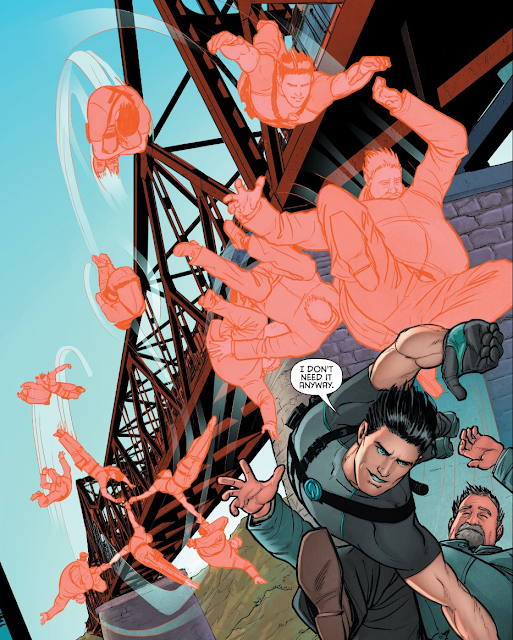

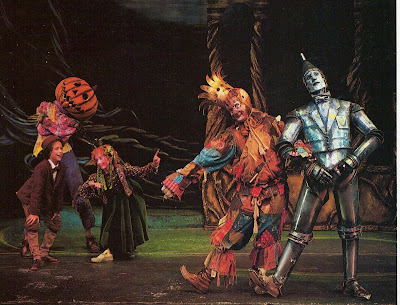



.jpg)


